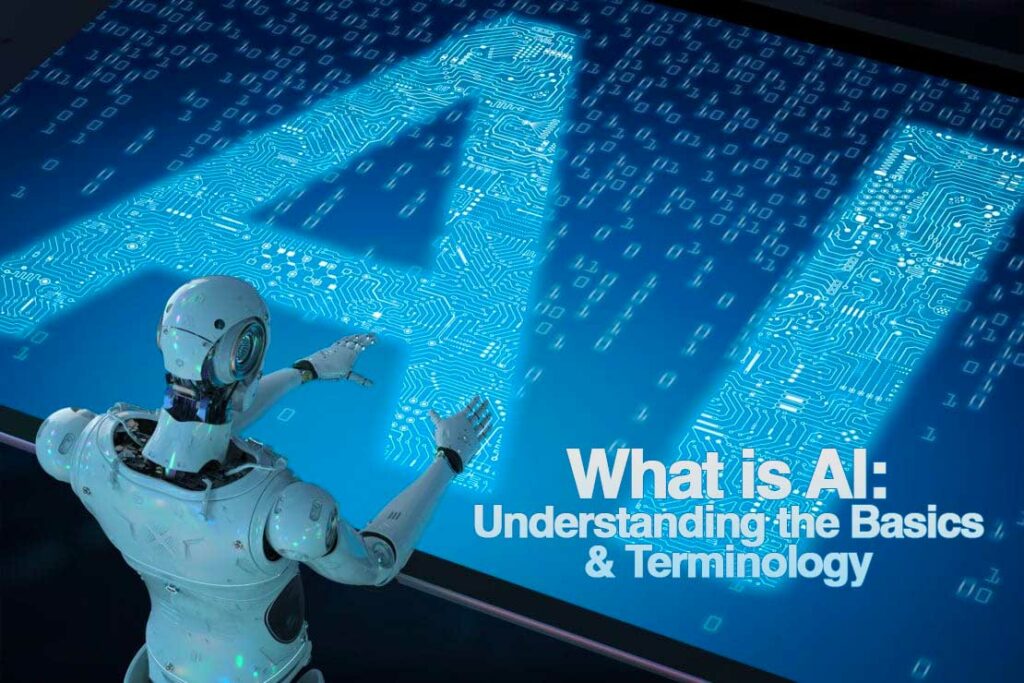Artificial intelligence (AI) has become a ubiquitous topic of discussion in recent years. Its presence is evident in popular media, such as films and television shows, and in thought-provoking articles that often emphasize its potential to revolutionize our world or even evoke concerns about its sentience leading to doomsday scenarios.
However, amidst the varying perspectives, there is one undeniable fact: artificial intelligence is a tangible and handy tool for humanity. It is very much real and is here to revolutionize our lives! It has given some new terms to our daily vocab that we haven’t heard of before. Hence, understanding the basics of AI and its associated terminology can be overwhelming for those new to the field.
In this blog post, we will delve into the fundamental concepts of AI and provide a clear understanding of its basics and common terminology.
Understanding Artificial Intelligence:
When most people hear the term artificial intelligence, the first thing they usually think of is robots. Big-budget films and novels weave stories about human-like machines that wreak havoc on Earth. But nothing could be further from the truth.
Artificial Intelligence refers to developing intelligent systems that can perform tasks that require human intelligence.
AI encompasses various techniques, methodologies, and algorithms that enable machines to simulate human-like cognitive processes, such as learning, problem-solving, reasoning, and decision-making. The ideal characteristic of artificial intelligence is its ability to rationalize and take actions that have the best chance of achieving a specific goal.
Types of Artificial Intelligence:
Artificial intelligence can be divided into two different categories (based on capabilities):
Narrow AI (Weak AI):
Narrow AI, also known as Weak AI, focuses on a specific task or domain. These AI systems are designed to excel at specific functions, such as speech recognition, image classification, or recommendation systems.
General AI (Strong AI):
General AI aims to develop machines with human-like intelligence that can understand, learn, and apply knowledge across various domains. This level of AI remains hypothetical and is currently the subject of ongoing research. General AI can perform any intellectual task that a human can do.
Key AI Terminology:
Let’s take a closer look at the key terms to understand the working of AI:
- Machine Learning (ML): Machine Learning is a subset of AI that focuses on creating algorithms and models that enable machines to learn from data without being explicitly programmed. ML algorithms can identify patterns and insights from vast amounts of data, allowing machines to make predictions or decisions based on their learnings.
- Deep Learning: Deep Learning is a subfield of ML that utilizes artificial neural networks inspired by the structure of the human brain to process and understand complex patterns in data. Deep Learning algorithms excel in tasks such as image and speech recognition. Neural networks with multiple hidden layers form the basis of Deep Learning models.
- Neural Networks: Neural networks are computational models composed of interconnected nodes, known as artificial neurons or units, organized in layers. Each neuron receives input, processes it using an activation function, and produces an output. Neural networks are fundamental to many AI algorithms, including Deep Learning.
- Training and Inference: In AI, training involves feeding data into a model and adjusting its parameters to optimize performance. The trained model learns from labeled data, making it capable of making accurate predictions or decisions. Inference is deploying a trained model to predict or decide on new, unseen data.
- Supervised Learning: Supervised Learning is a type of ML where a model learns from labeled data. It involves mapping input data to corresponding output labels. For example, the model is trained on labeled images to recognize specific objects or features in an image recognition task.
- Unsupervised Learning: Unsupervised Learning is a type of ML where a model learns from unlabeled data. It aims to discover patterns or structures in the data without specific guidance. Clustering algorithms, which group similar data points together, are a common application of unsupervised learning.
- Reinforcement Learning: Reinforcement Learning involves training an agent to make decisions within an environment. The agent learns through trial and error, receiving rewards or penalties based on actions. The agent improves its performance over time by optimizing its actions to maximize cumulative rewards.
Challenges and limitations of AI
Although AI is undoubtedly recognized as a significant and rapidly evolving asset, this emerging field has drawbacks.
In a 2021 survey conducted by the Pew Research Center, 10,260 Americans were asked about their attitudes toward AI. The results revealed that 45 percent of respondents held an equal mix of excitement and concern, while 37 percent expressed more concern than excitement. Interestingly, over 40 percent of participants considered driverless cars negatively affecting society. On the other hand, the idea of utilizing AI to detect and combat the spread of misinformation on social media was relatively well-received, with close to 40 percent of those surveyed viewing it as a positive concept.
Undeniably, AI offers numerous benefits, such as enhancing productivity, improving efficiency, and minimizing the potential for human error.
However, it is essential to acknowledge the existence of certain disadvantages.
- For instance, developing and implementing AI technologies can incur substantial costs.
- Additionally, there is a valid concern regarding automated machines’ potential replacement of human jobs.
While the advantages of AI are evident, society must navigate its potential drawbacks thoughtfully, striving for a balance that maximizes the benefits while addressing the concerns. Open discussions, ethical considerations, and continued research and development can pave the way for AI’s responsible and beneficial integration into various aspects of our lives.
Key takeaways:
- Artificial Intelligence holds immense potential for transforming industries and shaping our future. By understanding the basics of AI and the associated terminology, we can better comprehend the advancements and applications of this technology.
- AI offers vast possibilities, from narrow AI systems that excel at specific tasks to the theoretical concept of general AI.
- Familiarizing ourselves with terms like Machine Learning, Deep Learning, neural networks, and different learning paradigms allows us to grasp the foundational elements of AI.
- As AI continues to evolve, acquiring a solid understanding of its basics and terminology will become increasingly valuable in navigating the ever-changing landscape of artificial intelligence.






